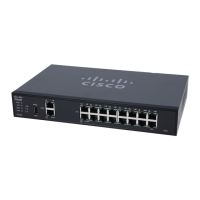To configure dynamic DNS policies, follow these steps:
Step 1
Select WAN > Dynamic DNS.
Step 2
In the Dynamic DNS Table, select the interface (WAN1, WAN2, USB1, or USB2) to add to the Dynamic DNS policy.
Step 3
Click Edit.
Step 4
Check Enable this Dynamic DNS policy to enable the policy configuration.
Step 5
Select the name of service provider from the Provider drop-down list.
Step 6
Enter a Username and Password for the DDNS account.
Step 7
Enter the full name of the device including the domain name in Fully Qualified Domain Name.
Step 8
Check Enable to receive updates to Dynamic DNS provider and select the periodicity.
Step 9
Click Apply.
Step 10
Click Refresh to refresh the Dynamic DNS Table.
Hardware DMZ
A Demilitarized Zone (DMZ) accepts all incoming traffic and allows all outgoing traffic. A DMZ is a
subnetwork that is open to the public but behind the firewall. A DMZ allows you to redirect packets entering
your WAN port to a specific IP address. You can configure the firewall rules to allow access to specific
services and ports in the DMZ from both the LAN and WAN. If there is an attack on any of the DMZ nodes,
the LAN is not necessarily vulnerable. We recommend that you place hosts that must be exposed to the WAN
(such as web or email servers) in the DMZ network.
To configure the hardware DMZ configuration, follow these steps:
Step 1
Select WAN > Hardware DMZ.
Step 2
Click Enable to change the LAN4 to DMZ port.
Step 3
Select Subnet to identify a subnetwork for DMZ services and enter the DMZ IP Address and Subnet Mask.
Step 4
Select Range (DMZ & WAN within the same subnet) and enter the IP range.
Step 5
Click Apply.
IPv6 Transition
For migrating from IPv4 to IPv6, you can use an Internet transition mechanism called 6in4. The 6in4 uses
tunneling to encapsulate IPv6 traffic over configured IPv4 links. The 6in4 traffic is sent over the IPv4, in
which the IPv4 packet header. This is followed by the IPv6 packet whose IP headers have the IP protocol
number set to 41.
RV345/345P Administration Guide
44
WAN
Hardware DMZ

